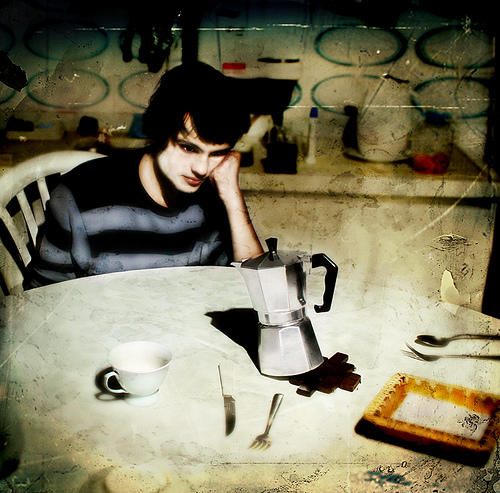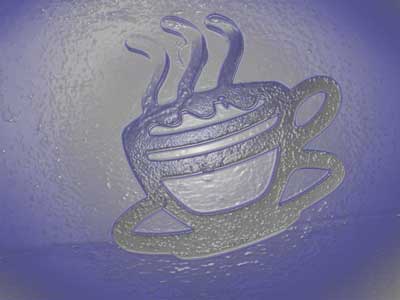Frequently Asked Questions
Why Dark Coffee Is Easier on Your Stomach
Roasting coffee beans impart a bold, rich flavor. In addition, the longer it is roasted, the more it creates a compound that helps dial down production of stomach acid. The discovery may explain why dark-roasted brews are gentler on the stomach than their lighter peers. For more information, read this Wired Science article.
How do you steam milk?
2% is the easiest to make great froth with. When you first start to heat the milk, put the tube close to the bottom. This allows the steam to "touch" more milk, which heats it quicker. Once it is almost to the correct temperature, then bring the tube closer to the top of the milk, which will give you more foam, but less heat.
I have heard that coffee can prevent some forms of cancer. Is this true?
Having four cups of coffee a day can reduce the risk of colorectal cancer so says the American Journal of Epidemiology, Edward Giovannucci, M.D. of Harvard Medical School, Coffee increases the frequency of bowel movements, which may limit the colon's exposure to carcinogens. But, you still need to eat healthy, exercise, and quit smoking.
Have you ever heard of a very expensive coffee that was processed in a unique way? Monkeys eat the coffee cherries and when the beans come out the other end someone gathers the beans and cleans them (i hope) and packages them for sale?
At about $200 or more a pound, Kopi (the Indonesian word for coffee) Luwak, may be the most expensive cuppa joe in the world. It's made from coffee beans eaten and then excreted by the luwak, (a.k.a. Asian Palm Civet) a marsupial native to Indonesia:
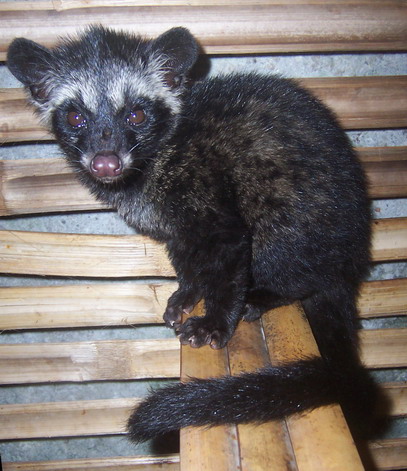
Photo by W. Djatmiko
The coffee cherry is eaten by Luwaks, which ferments the beans in their stomach. The beans soon pass through the digestive system undigested. It was thought that he beans remained unharmed as they retained the pergamino or husk, which prevents them from coming into contact with anything else in the stomach of the Luwak. However, it is now believed that the digestive juices of the civet actually penetrate the beans and change the proteins, resulting in their unique flavor (Marcone, 2007. In Bad Taste: The Adventures And Science Behind Food Delicacies).
Kopi Luwak is produced in Sumatra, Java, and Sulawesi. In the Philippines it is called Kape Alamid, in East Timor kafe-laku, while in Vietnam it is called weasel coffee.
Where does the word coffee come from? Also, how about some of those other words, such as Latte?
Coffee came to Europe from the Middle East, where its name was qahveh, an Ottoman Turkish pronunciation of Arabic qahwah, the Turks having borrowed the word and the drink from the Arabs. Our form of coffee results from combining caffe, the Italian version of the Middle Eastern word, and the vowel of the Middle Eastern word, represented by o. Coffee is first recorded in English in 1601 with the spelling coffe.
Caffe Latte is Italian for coffee (caffe) milk (latte). So technically, if you just ask for a Latte, then you are asking for milk. But hey, we always taken more of a relaxed view.
What is the difference between Cappuccino, Cafe au Lait, and Cafe Latte?
The Capuchin order of friars, established after 1525, played an important role in bringing Catholicism back to Reformation Europe. Its Italian name came from the long, pointed cowl, or cappuccino, derived from cappuccio, "hood," that was worn as part of the order's habit. The French version of cappuccino was capuchin (now capucin), from which came English Capuchin. The name of this pious order was later used as the name (first recorded in English in 1785) for a type of monkey with a tuft of black, cowl-like hair. In Italian cappuccino went on to develop another sense, "espresso coffee mixed or topped with steamed milk or cream," so called because the color of the coffee resembled the color of the habit of a Capuchin friar. The first use of cappuccino in English is recorded in 1948 in a work about San Francisco.
The frothed milk from the top of the steaming pitcher is spooned on top to "cap" the cappuccino and retain heat. The proportion of espresso to steamed and frothed milk for cappuccino is usually 1/3 espresso, 1/3 steamed milk and 1/3 frothed milk on top.
Cafe au Lait is 2/3 cup of coffee and 1/3 cup of milk. Pour the coffee into the cup. Steam the milk and add to coffee leaving a layer of foam at the top. Sprinkle with cinnamon, nutmeg, or chocolate powder if desired.
Cafe Latte adds steamed milk (150-170 F) to a freshly drawn shot of espresso. Finish with a quarter inch of foamed milk. NOTE: Some like to add the shot of espresso last. Pour slowly into the center of the cup. If desired, sprinkle with chocolate or cinnamon.
I've recently purchased a French Press and I find that it makes the best coffee I've ever tasted. The only problem is that I hear that the extra oils can be unhealthy. Is this so?
Coffee that goes through a paper filter has much of the coffee oil trapped in the filter. This oil contains fat so you get more fat with a French press and a percolator. But, coffee that goes through a paper filter picks up some of the paper's taste... and have you ever driven by a paper plant and noticed the odor? That odor and the paper taste are the same - chemicals!
So with drip coffee makers you get chemicals. With French presses you get more fat, which can raise your cholesterol level. So...my choice is to have coffee with no chemicals but more cholesterol, eat less fat to make up for the difference, eat more green leafy veggies containing Folic Acid (at least 400 micrograms a day) which reduces cholesterol, get annual check-ups and lead a balanced lifestyle. It sounds much better to me than coffee with chemicals that does not taste as great.
Do you know of any home roasters on the Market? Also, I am looking to purchase green beans.
From "The Improved Housewife" 1843: "... dry them first in an iron pot, over a moderate fire, for some hours before they are roasted. Hang the pot so high as to not burn it. After drying three or four hours, place it on a hot bed of coals, and stir it constantly until roasted enough which is determined by biting one of the lightest colored kernels. If brittle, pronounce the whole thing done."
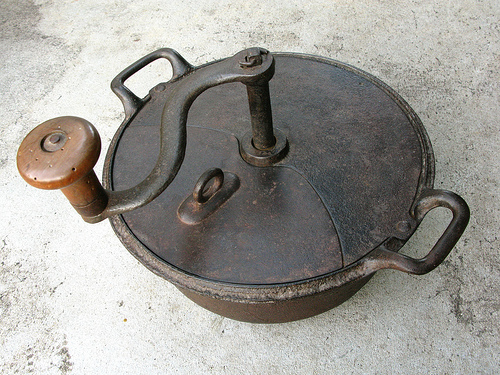
photo by tonx
Check out these sites, they should be able to help you: Coffee Bean Corral or The Coffee Project
Where can I learn about the coffee business?
Can coffee be stored in the freezer?
If the bag is airtight, the coffee can be stored in the freezer. This will keep it fresh much longer. The trouble is getting the bag airtight. Many mail order companies and the coffee you buy off the shelf is packaged in an vacuum pack metal-foil or plastic bag. But, when you open it and then reseal it, how can you be sure the bag is still airtight? And if you buy coffee out of large containers and then package it yourself, how can you be sure the bag is airtight when you place it in the freezer? Also, I think that people's success for storing coffee (that is not in a vacuum pack bag) in the freezer, has a lot to do with the amount of humidity in the air, what is stored in the freezer, etc. This is why some say it works, and others say do not do it.
Your best bet is to store it in a glass or ceramic container that has an airtight lid.
What type of grinder should I buy?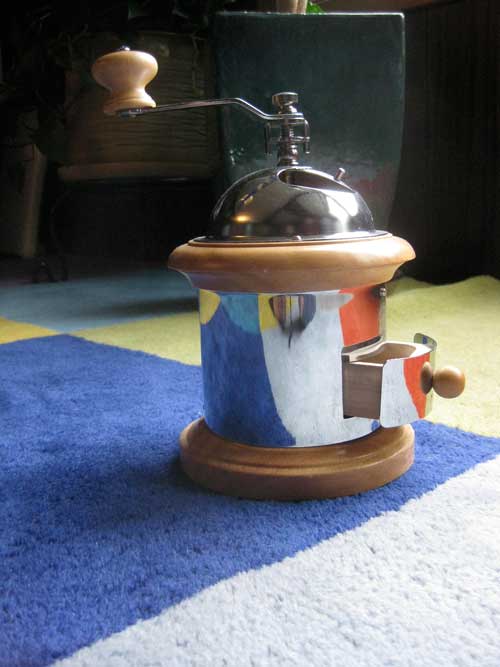
As far as grinders go, there are two main types:
- A BLADE grinder has sharp blades in it, which cut the beans up. They are harder to get a consistent grind, but with some practice they can work real good. The main advantage is that they are cheaper to buy.
- A BURR grinder works by the beans going through a set of crushing wheels. The wheels can be adjusted for the desired grind. These work the best but they are much more expensive. This is what is used at specialty coffee stores, they are just bigger versions of home models.
What are the types of grinds?
The grind you select is determined by how you intend to brew your coffee. The following guidelines are far blade type grinders. Also, shaking the grinder vigorously while grinding seems to produce a more consistently and even coffee grounds. Grinding times:
- Course: 10 seconds for French press/manual plunger type pots. Also called Bodums.
- Medium: 15 seconds for flat bottom filters, drip brewed
- Fine: 24 seconds for Melitta style or cone shaped filters, drip brewed
- Ultra Fine: 30 seconds for espresso machine
- Powder: 35 seconds for Turkish coffee
Grinding your beans too fine does not mean you will get more mileage out of them; rather, your coffee will be bitter or "over-extracted." Grinding your beans too coarse will cause the coffee to be weak and watery or "under-extracted."
Is there a chemical-less or waterless method of removing caffeine? I do not want any chemicals in my coffee and the water method does not produce as good of a cup.
NOTE: Thanks to Jesse R. Grenz, University of Minnesota, Dept. of Biochemistry, for the answer to this question.
A new method was developed that is slightly more expensive. Liquefied carbon dioxide (really high pressure at a low temperature) is passed over the beans. This causes the caffeine to go into solution in the CO2. The beans are kept above the bottom of the chamber, so as when the pressure is released, the CO2 is released as gas (or sometimes forms a solid if not done correctly) and the caffeine precipitates in crystal form to the bottom of the chamber.
It was found that even the traces of methylene chloride used in the chemical decaffination process were harmful. Any chemicals left in this process are supposedly evaporated during the roasting process. This is true, for the most part. However, there can be some reactions between methylene chloride (CH2Cl2) and some of the materials in the bean itself. It probably doesn't pose too much of a problem, unless one drinks as much coffee as I do times about a thousand. Nevertheless, there were some complaints (but less than when carbon-tet was used for some food treatments). I'm not certain how often the liquid CO2 process is used in comparison to others, though.
Is there a good robusta bean that's worth drinking?
There is one, but is has to be prepared in a special way. Vietnam's growing conditions place a hard demand on arabica coffee so that robusta is the main crop grown there. A heaping teaspoon of coffee, ground to a medium-fine consistency, is placed in a special Vietnamese style filter. A top screen is then place on top of the grounds and screwed down tight. This is then placed on top of a small cup (about 4 oz.) and filled with boiling water until it is about 1/4 full. After the grounds have moisturized, about 30 seconds, the top screen is loosened one full turn. Now the filter is filled with boiling water and a lid is placed on top. About 15 minutes later (this is only for the patient) the dripping will stop. Enjoy!
Since coffee is derived from the name of Ethiopia's Kaffa region, how "American" is it to drink?
When American colonists dumped hundreds of chests of tea into Boston Harbor during the "Boston Tea Party", coffee drinking became a patriotic duty. It gave a whole new meaning to "Bean Town."
Why do whole beans stay fresher longer than ground coffee?
Since there is less surface area on a whole bean as compared to the same amount of ground coffee, it cannot be attacked as much by its deadly flavor robbing enemy... oxygen. Oxygen is one of the worst enemies of coffee -- it is what causes it go stale. Since ground coffee has more surface area than a coffee bean, there is a lot more area for it to attack, thus ground coffee will normally go stale faster than coffee beans

